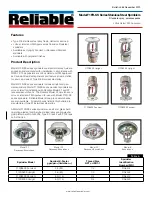
Istruzioni per l’uso
PMB136
4
-
PMS2000 System
-
2.
MONTAGGIO
L’installazione e la configurazione di queste postazioni
microfoniche (o, più brevemente,
basi) deve essere effettuata
da personale tecnico qualificato. Le basi dispongono di quattro
piedini in gomma che ne impediscono lo scivolamento e le isolano
elettricamente dal piano di appoggio; in alternativa, possono
essere incassate nel piano stesso.
ATTENZIONE
!
Nel caso si opti per il montaggio ad incasso, si tenga presente
che in questo modo potrebbe venirsi a creare un collegamento
diretto tra il telaio metallico della base ed il piano d’appoggio (il
telaio metallico è connesso al negativo della circuitazione).
Una volta incassata, la base deve essere fissata al piano
mediante il montaggio delle squadrette contenute nel kit
accessorio
AC501
, rimuovendo, allo scopo, le due viti [
C
] dai
pannelli laterali [
A
] e [
B
] della base (figura 2.1.1); posizionare,
quindi, le due squadrette [
D
] su entrambe le fiancate premendo
il lato più corto di queste contro il piano di appoggio e riavvitare
le viti [
C
] (precedentemente rimosse) con le rondelle [
E
] incluse
nel kit. Nella presa [
1
] deve essere innestato uno tra i modelli di
microfono riportati più avanti nella sezione accessori,
avvitandone a fondo la ghiera di fissaggio [
22
] della spina [
23
]
posta alla base dello stelo.
2.
ASSEMBLY
These microphone stations (also known, more briefly, as
bases),
must be installed by qualified technical personnel.
Each base has four rubber feet that stop them from slipping
and provide electrical insulation from the surface on which they
are placed. As an alternative, they may also be flush-mounted
into the top.
WARNING
!
If it is decided to flush-mount the bases, it must be kept in mind
that in this way a direct connection between the metal frame of
the base and the surface on which it is mounted could be created
(the metal frame is connected to the negative of the circuitry).
Once the base has been flush-mounted, it must be secured to
the surface by mounting the small set squares contained in the
accessory kit
AC501
. In order to do this, remove the two
screws [
C
] from the side panels [
A
] and [
B
] of the base (Figure
2.1.1). Then position the two set squares [
D
] on either side,
pressing the shorter side of each square against the mounting
surface and screw the screws [
C
] (which had previously been
removed) back into place using the washers [
E
] included in the
kit. One of the two models of microphone indicated below in the
section on the accessories has to be secured firmly into the
socket [
1
], screwing the ring-nut [
22
] for securing the pin [
23
]
at the base of the stem right in.
Fig. 2.1.1
Fig. 2.1.2
Fig. 2.1.3
Fig. 2.1.4
Nel caso si rendesse necessario separare galvanicamente l’uscita
audio della base microfonica dall’ingresso dell’impianto di
amplificazione, occorrerà installare la scheda accessoria
AC32
seguendo la procedura di seguito descritta:
1.
rimuovere entrambe le fiancate ([
A
] e [
B
]) della base
microfonica, svitando le tre viti di fissaggio per ogni lato
(vedi fig. 2.1.2);
2.
sollevare il pannello superiore e l’assieme circuito tasti (con
il relativo telaio di sostegno) come mostrato in fig. 2.1.3.
If it becomes necessary to separate the audio output of the
microphone base galvanically from the input of the amplification
system, the
AC32
accessory card will have to be installed,
following the procedure described below:
1.
Remove both side panels ([
A
] and [
B
]) from the
microphone base after unscrewing the three fixing screws
on each side (see Figure 2.1.2):
2.
Lift the upper panel and the key-circuit assembly (together
with its supporting frame) as illustrated in Figure 2.1.3.





































